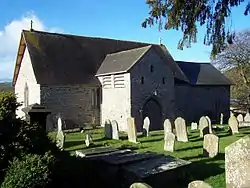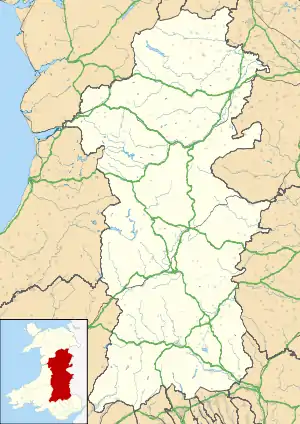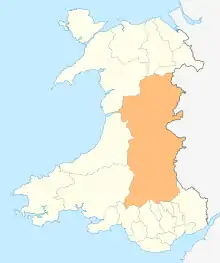Llanigon
Llanigon is a village and community in Powys, Wales on the edge of the Brecon Beacons National Park, north of the Black Mountains, Wales. The community population was 478.[1] The nearest town is Hay-on-Wye, some 1.5 miles (2 km) to the east. It is in the historic county of Brecknockshire.
| Llanigon | |
|---|---|
 St Eigon's Church | |
 Llanigon Location within Powys | |
| Population | 478 |
| Principal area | |
| Ceremonial county | |
| Country | Wales |
| Sovereign state | United Kingdom |
| Post town | HEREFORD |
| Postcode district | HR3 |
| Dialling code | 01497 |
| Police | Dyfed-Powys |
| Fire | Mid and West Wales |
| Ambulance | Welsh |
| UK Parliament | |
History
The parish church is dedicated to the mysterious Saint Eigon, who may have been a daughter of Caratacus or (more probably) a brother of Saint Cynidr of nearby Glasbury.[2][3] The former interpretation has inspired Barbara Erskine's novel The Warrior's Princess, partly set in Llanigon.[4] The church predates the Norman Conquest, though the current building (parts of which are Norman) is somewhat later.[5][6]
The manor was formerly known as Llanthomas (or Thomas Church) and was part of the lordship of Hay. Remains of a motte, believed to be 11th or 12th century, survive near the old manor house,[7] which was demolished in the 20th century. In 1522, the manor belonged to Walter Devereux, 1st Viscount Hereford [8] and was said to be the birthplace of William Thomas.[9]
Llwynllwyd barn, to the west of the village, was a dissenting academy in the eighteenth century. The pioneer Welsh Methodist Howell Harris[10] and the hymn writer William Williams Pantycelyn[11] were both educated there.
In the 1870s the diarist Francis Kilvert, curate of Clyro, was a regular visitor to the then vicar of Llanigon, the Rev. William Thomas, and fell in love with his daughter, Daisy. Her father asked Kilvert not to pursue the matter, probably because as a mere curate he was not sufficiently well-placed. Kilvert noted "On this day when I proposed for the girl who will I trust one day be my wife I had only one sovereign in the world, and I owed that." Daisy never married and is buried in Llanigon churchyard.[12]
Notes
- "Archived copy" (PDF). Archived from the original (PDF) on 8 June 2011. Retrieved 22 June 2009.CS1 maint: archived copy as title (link)
- "St. Eigon's, Llanigon". Archived from the original on 6 July 2008. Retrieved 16 July 2016.
- S. Baring-Gould, The Lives of the British Saints Vol. 3 https://archive.org/stream/livesofbritishsa02bariuoft#page/416/mode/2up
- "Archived copy". Archived from the original on 3 October 2009. Retrieved 22 June 2009.CS1 maint: archived copy as title (link)
- Rev. W. E. T. Morgan, Hay and neighbourhood, 1932.
- "Clwyd-Powys Archaeological Trust – Projects – Longer – Historic Churches – Brecknockshire Churches Survey – Llanigon". cpat.demon.co.uk. Retrieved 16 July 2016.
- "Clwyd-Powys Archaeological Trust – Projects – Historic Landscapes – Middle Wye – Administrative Landscapes". cpat.org.uk. Retrieved 16 July 2016.
- "Full text of "Historical memoranda of Breconshire; a collection of papers from various sources relating to the history of the County"". archive.org. Retrieved 16 July 2016.
- "Member Login | Questia School, Online Research Library for Secondary and High Schools". questiaschool.com. Retrieved 16 July 2016.
- "Archived copy". Archived from the original on 12 September 2012. Retrieved 24 June 2009.CS1 maint: archived copy as title (link) The early life of Howell Harris
- Rev. W.E.T. Morgan, Hay and neighbourhood, 1932.
- C. Barber, Exploring Kilvert Country ISBN 1-872730-24-8
